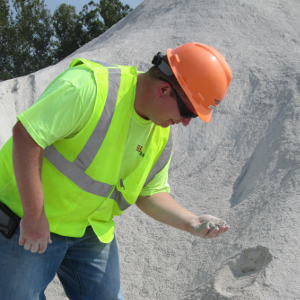Crushed stone aggregates are produced by crushing quarried rock, then screening it to sizes appropriate for the intended use.
Production of crushed stone has three stages: Primary crushing to break down the stone to a manageable size; secondary and tertiary crushing to render the rocks into sizes specific to their applications; and screening to separate the crushed stone for further processing or for finished products sizes.

Fine
Fine crushed stone aggregates consist of particle sizes that are typically less than 3/8-inch (9 mm). Fine aggregates are used in asphalt, concrete, backfill, construction and specialty applications.
Common uses for fine crused stone
• Concrete
• Asphalt
• Backfill and bedding materials
• Skid resistance on ice or snow
• Agricultural-lime (Ag-lime)
• Stabilized earth or reinforced soils
Sizes and Designations
ASTM, AASHTO & DOT products available.
Common designations include, but are not limited to: Concrete Sand, Asphalt Sand, Manufactured Sand (Man Sand), Dry & Washed Screenings

Coarse
Coarse aggregates consist of gravel, crushed stone or recycled concrete with particle sizes of ranging from 3/8-inch to 1.5 inches. Coarse aggregates are used in a wide range of construction applications, notably in concrete and asphalt mixes.
Common uses for coarse crushed stone
• Concrete aggregate
• Asphalt aggregate
• Drainage stone
• Seal coat chips for roadways
• Stone roads and driveways
• Road base
• Backfill
Sizes and Designations
ASTM, AASHTO & DOT products available.
Common designations include, but are not limited to: #4, #467, #5, #56, #57, #6, #67, #7, #8, #89, #9

Base Coarse
Dense-graded base course refers to crushed stone aggregates with a range of particle sizes, usually 1-1/2-inch and smaller, that produce a dense layer of stone with a minimum amount of voids.
Common uses for base coarse crushed stone
• Foundation for asphalt pavement
• Foundation for concrete pads and pavements
• Unpaved roads and shoulders
• Backfill for pipe and underground utilities
• Cement-treated base
Sizes and Designations
Sizes and designations vary by location due to governing agency requirements.
Common designations include, but are not limited to: Base, Subbase, Dense Graded Base, -Crushed Stone Base, Graded Aggregate Base (GAB), Aggregate Base Coarse(ABC), Macadam Base Coarse (MBC)

Ballast
Large coarse aggregates that consist of crushed stone (hardstone such as rhyolite, granite and sometimes dolomite) with particle sizes ranging from 1 ½ inches to 4 inches. Typical uses include construction applications and railroad ballast.
Common uses for ballast crushed stone
• Railroad ballast
• Construction entrances
• Rough site pads
Sizes and Designations
ASTM, AASHTO & AREMA products available.
Common designations include, but are not limited to: #1, #2, #3, #4, #5

Rip-Rap
Rip-Rap is large pieces of crushed stone (4 inches or larger) typically used to protect shorelines and slopes from erosion and runoff. Architectural and landscaping applications are also common.
Common uses for rip-rap
• Erosion control
• Runoff protection
• Slope stability
• Landscaping
• Architectural applications
• Gabion baskets
Sizes and Designations
Sizes and designations vary by location due to governing agency requirements. Contact a sales representative near you

Specialty Products
Crushed aggregates can fulfill specialized functions outside of construction, such as industrial processes and household and landscaping uses.
Common Uses
• Agricultural lime agent to treat soil (Ag-lime)
• Mineral filler or fine grind, currently available from Hanson at Thornton IL, Nokomis IL, Plum Run OH, Sandusky OH, or Watertown NY.
• Landscaping stones
• Skid resistance on ice or snow
• Chemical stone
• Scrubber stone to treat flue gases
• Filter courses for septic systems
Sizes and Designations
Sizes and designations vary by location due to governing agency requirements. Contact a location representative for more information.

